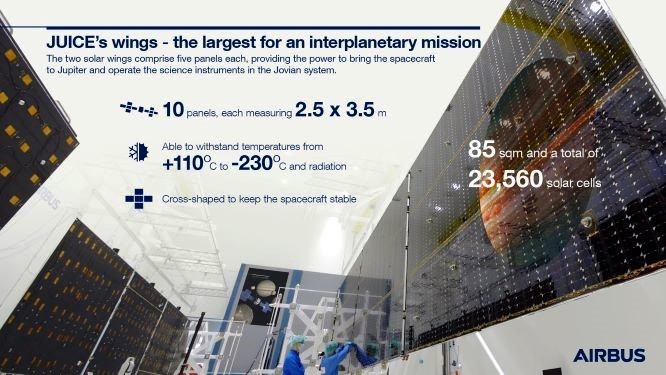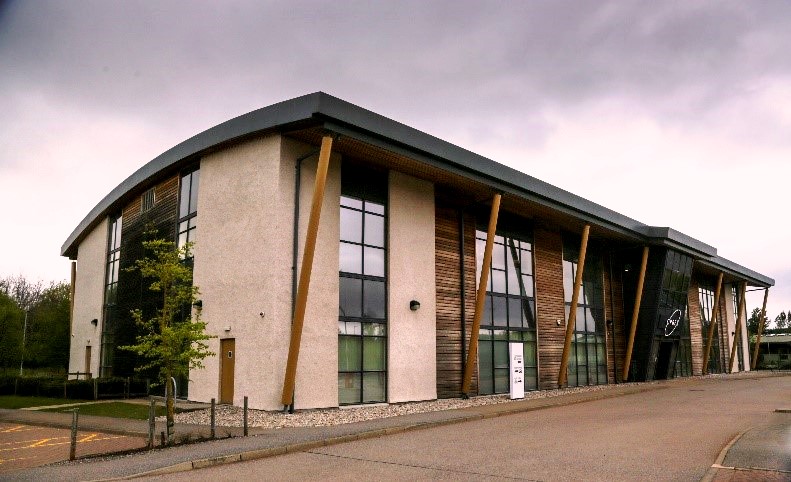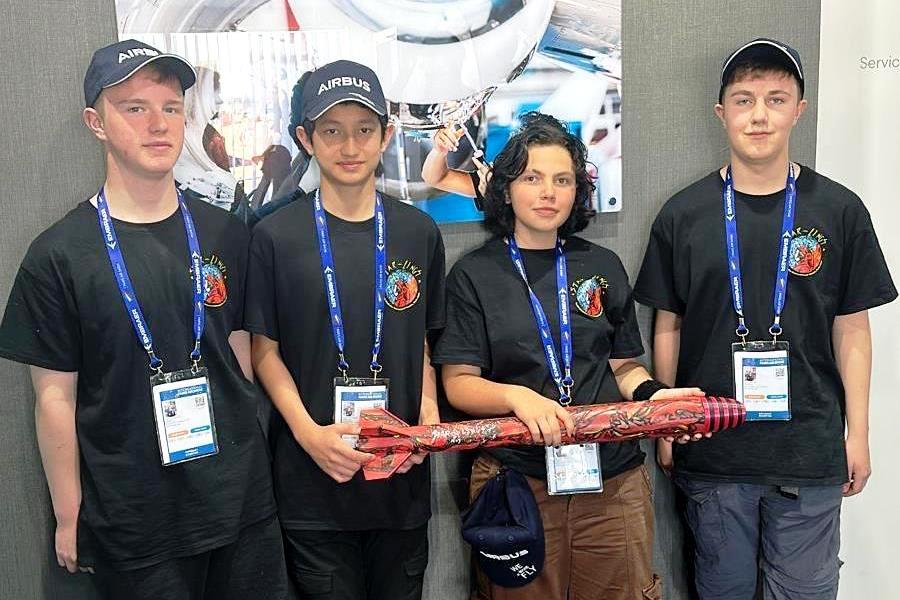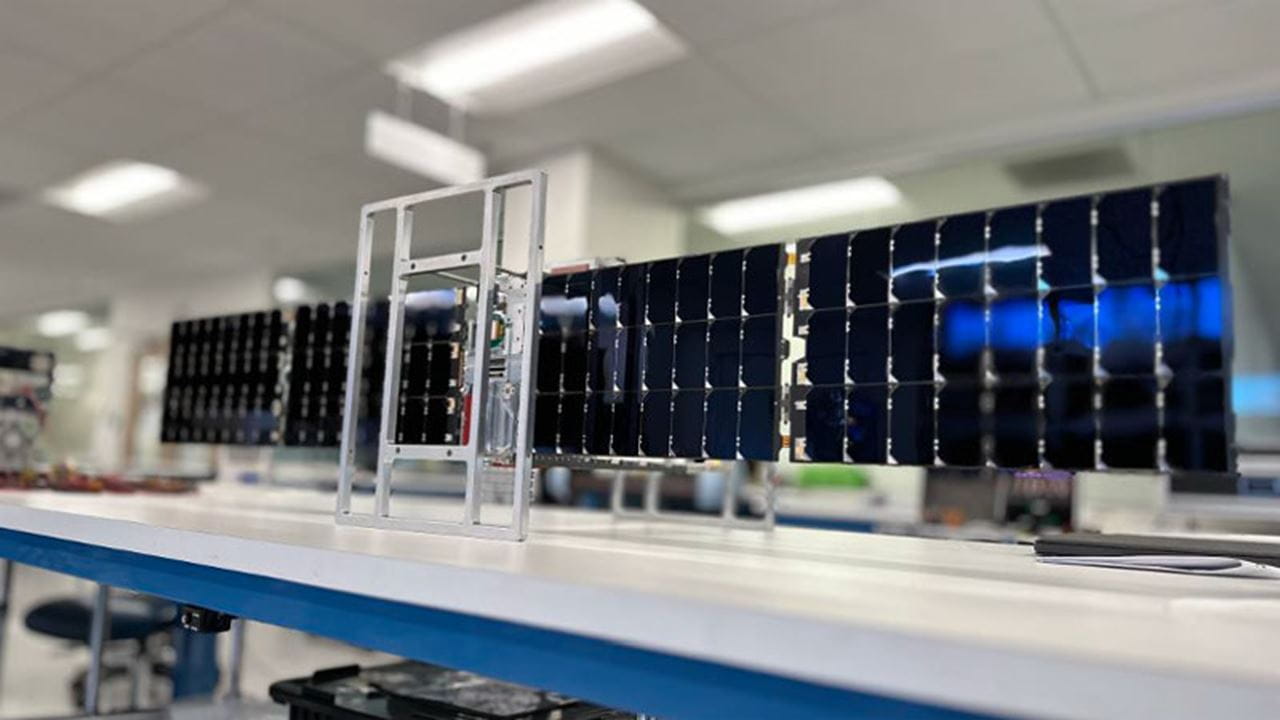JUICE begins its ESA mission to Jupiter

Image copyright Airbus
The ESA spacecraft operations team at the European Space Operations Centre (ESOC) in Darmstadt, Germany, took control of the spacecraft and confirmed reception of the first telemetry and the smooth deployment of the solar arrays. The Airbus-built JUICE is now officially on its way to Jupiter.
Additional equipment and instruments will be progressively turned on in the next few days and the operations team will run tests to make sure they are all fully operational.
“After years of work, watching this launch live from our sites across Europe was a very emotional moment for all those who have worked on this incredible mission. This is the best of Europe coming together!” said Michael Schöllhorn, CEO Airbus Defence and Space from Kourou. “I’m eager to see the next big thing coming from the European space community.“
JUICE: a European shared success
Bringing together 80 partners across 23 countries and harnessing the brainpower of 2,000+ people, Airbus has designed and built JUICE under contract to the European Space Agency (ESA).
On its over five billion kilometre long journey, the 6.2 tonne JUICE spacecraft will make a series of flybys of Callisto, Ganymede and Europa, collecting data to try to understand whether there is any possibility that the moons and their subsurface oceans could host microbial life.
Carrying 10 state-of-the-art scientific instruments, including cameras, spectrometers, an ice-penetrating radar, an altimeter, a radio-science experiment, a particle package and various magnetic and electric field sensors, the JUICE spacecraft will complete a unique four-year tour of the Jupiter system.
JUICE is due to arrive at Jupiter in 2031 after a series of gravity slingshots from Venus and Earth to propel it on its way.
Funded by the UK Space Agency, the UK leads on one of the 10 science instruments on board the European Space Agency’s Jupiter Icy Moons Explorer (JUICE) and has contributed to the development of two more.
Secretary of State for Science, Innovation and Technology, Michelle Donelan, said: "The UK Space Agency has invested around £9 million in the JUICE mission to explore Jupiter and its moons. UK tech on the spacecraft illustrates how our world class universities and research institutions are unlocking deep space exploration.
"I want the UK’s space sector to continue thriving and encourage STEM learning for the next generation. It’s important that we push the boundaries of science, innovation and technology across the country to support the jobs of the future."
On arrival in 2031, JUICE will circle Jupiter and fly past moons Ganymede, Europa and Callisto, making observations and taking measurements, studying the Jovian system as an archetype for gas giants elsewhere in the universe.
Finally in December 2034, JUICE will transfer into orbit around Ganymede, becoming the first spacecraft ever to orbit a moon other than Earth’s. While up close and personal with Ganymede, the mission will investigate the giant ocean that scientists believe hides under its icy crust, seeking evidence of habitability.
Dr Caroline Harper, Head of Space Science at the UK Space Agency, said: "The launch of JUICE marks years of hard work and collaboration by scientists, engineers and space agencies all over the world but the journey is far from over.
"We look forward to following the spacecraft as it makes its eight-year trip to Jupiter and then as it studies the planet and its moons, using specialised UK-developed science instruments.
"We have a large community of research experts in the UK who are eagerly awaiting the data that JUICE will provide. With this information we hope to discover more about the nature of gas giants in space and their icy moons, bringing us another step closer to understanding the evolution of the Universe."
The UK Space Agency invested £9 million into the JUICE science payload, by supporting three critical instruments on board, which are:
- J-MAG (UK-led magnetometer) – Development led by Imperial College London with radiation-hardness and mechanical design contributed by the University of Leicester.
- JANUS (Italian-led optical camera system) – Imaging sensors developed by Teledyne-e2v in the UK, then tested, calibrated and characterised by Open University.
- PEP (Swedish-led particle environment package) – Solid-state detectors provided by University College London and radiation design for instrument suite contributed by Aberystwyth University.
Principal Investigator for the J-MAG instrument at Imperial College London, Professor Michele Dougherty, has been involved in JUICE since well before it was selected by ESA in 2014 as the first Large Class mission in its Cosmic Vision Science Programme.
Professor Michele Dougherty, Head of the Department of Physics at Imperial College London, said: "With our instrument’s measurements, we are almost looking inside these worlds. What we’re doing, however, is extremely difficult, as the signals we’re trying to detect are extremely small. It’s like trying to find lots of needles in a haystack and those needles are changing shape and colour all the time. But we think the results are going to be spectacular.
"Space missions are long and slow, so launch only marks the halfway point of this one – because we first started thinking about it 15 years ago and we’ll be getting the last data in 15 years’ time."
JUICE is a collaboration between ESA, NASA and the space agencies of Japan and Israel and will consider two key themes from ESA’s Cosmic Vision 2015 – 2025: What are the conditions for planet formation and the emergence of life? And how does the Solar System work?
JUICE will spend its eight-year voyage productively; it will pass by Venus to test and calibrate its instruments, gather data and take advantage of the gravity assist to save on fuel. Meanwhile, scientists on the ground will work on finalising software and data modelling in time for arrival at Jupiter.
Chiaki Crews, Research Fellow at the Open University, said: "The JUICE mission aims to answer many exciting questions, including whether the ocean worlds beneath the surfaces of Jupiter’s icy moons could potentially harbour life. One of the many instruments needed to make detailed scientific observations to help answer such questions is a camera.
"Our team at the Open University has spent several years testing and optimising a new image sensor for JUICE’s scientific camera, JANUS. A large part of our work was to irradiate test sensors with high doses of radiation, just like it is expected to experience during the JUICE mission lifetime, to check that JANUS will still be able to take images without too much degradation.
"We are now very much looking forward to watching the launch, albeit we’ll have to wait patiently for several more years before we’ll see the first images sent back from Jupiter’s moons."
Professor Geraint Jones at University College London’s Mullard Space Science Laboratory, said: "It’s fantastic to see JUICE, carrying the PEP instrument that we contributed to, nearing its launch. We look forward to seeing data from our sensors on the ‘soup’ of ions, electrons and atoms surrounding Jupiter and its moons.
"This data will help us, for instance, to understand how particles around Jupiter reach such high energies – energies that could be fatal for an astronaut. We are excited that the mission will shed new light on worlds that could potentially host life."
Professor Emma Bunce, Director of the Institute for Space at the University of Leicester, said: "The JUICE mission represents the next logical step in our exploration of potentially habitable worlds in the outer solar system. The JUICE spacecraft will do that via multiple flybys of Europa, Ganymede and Callisto and eventually from a dedicated orbit at Ganymede towards the end of the mission.
"After many years of hard work from science, engineering and industry teams, we are so excited that the JUICE mission is finally ready to launch and start its long journey to the Jupiter system. We will patiently await the incredible data that we expect to receive from 2031 and we are confident that it will absolutely be worth the wait.”
Professor Manuel Grande, Head of Solar System Physics at Aberystwyth University’s Department of Physics, said: "The major challenge when visiting the icy moons of Jupiter, in particular Europa, is the extreme radiation environment which would interfere with the spacecraft’s instrumentation and swamp any readings.
"The innovative design of the shielding, which was pioneered at Aberystwyth, makes it possible to avoid the effects of radiation on readings and allow for the detection of organic molecules in the neighbourhood of Europa, which is perhaps the most likely site for life in our Solar System after our own Earth."
Daniel Waller, Vice-President at Teledyne e2v, said: "The launch of JUICE with the JANUS optical camera onboard marks a milestone in this important mission. This is our second complementary metal-oxide-semiconductor sensor from our facility in Chelmsford to fly in space in recent months. This sensor will give us sight of both the icy moons and the environment of Jupiter, increasing our understanding of other planets in our solar system."












